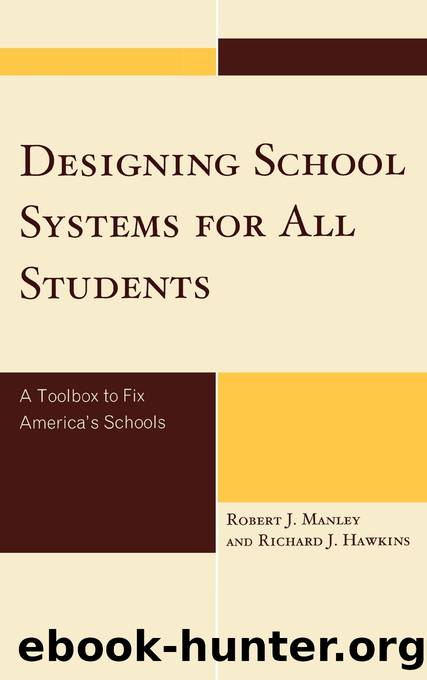Designing School Systems for All Students by Manley Robert J.;Hawkins Richard J.; & Richard J. Hawkins

Author:Manley, Robert J.;Hawkins, Richard J.; & Richard J. Hawkins
Language: eng
Format: epub
Publisher: R&L Education
Published: 2010-08-15T00:00:00+00:00
VISION AND MISSION ARE NOT SYNONYMOUS
As Rich began to serve as superintendent of a large, suburban school district that New York State Education Department classified as âlow wealth/high need,â a new commissioner of education was appointed. The standards movement in New York State changed from a Compact for Learning to a Contract for High-Stakes Tests.
Rich felt that students in his system were capable of higher achievement. He agreed wholeheartedly with the need to raise the bar for all students. He saw this statewide shift in governance as an opportunity to begin a discussion with his leadership team about his school districtâs culture. He asked questions about system structures and how well they aligned with the new standards.
After conducting a team effort to study the new standards, it quickly became apparent to his leadership team that the picture of student success that they held for themselves was simply incompatible with the new standards. The school system celebrated unique successes and allowed too many minimum-performance results.
In the low-stakes, minimum-competency environment his school personnel had been trained to accept, many believed that they were highly successful. However, in the new, more rigorous high-stakes testing environment they were entering, problems emerged.
The biggest problem of all was that the staff held a vision of the school system as one that performed beautifully as it was. In fact, in their minds, they were doing well and had the data to prove it. Recently, their schools had been honored and received the U.S. Department of Education Blue Ribbon Award three times, three New York State Schools of Excellence awards, the most outstanding music program in the nation by the Music Educators National Conference, and many other local, state, and national accolades and awards.
In fact, his school community, like most others, met the standards movement with the usual cynicism and contempt reserved for most change initiatives that required forced compliance with little or no input from the practitioners or support from the teachers who had to do the new work.
Some of his district leaders realized that the standards movement had tangible benefits for the children and the system. The implementation and accountability imposed by NCLB challenged old assumptions about students whose academic performance fell in the lower half of the bell-shaped academic curve.
In some districts, teachers compared raising standards to raising high-jump bars to levels âshort people could not clear.â The âbell curveâ which was intended to describe a normal distribution of behavior, attitude, or knowledge for a large group had become for them fixed quartiles into which all people should be slotted.
Once a student had been slotted inside a quartile, his or her achievement on academic standard exams was expected to remain in that quartile. School tracks were designed to keep children in their quartiles under the guise of âmeeting their needs.â Teachers referred to themselves by the student tracks in which they taught using phrases such as: Iâm an Advanced Placement teacher, or Iâm an Adjusted Track teacher.
When Rich raised questions about teacher assumptions regarding student performance, discontent and anger among faculty and staff appeared.
Download
This site does not store any files on its server. We only index and link to content provided by other sites. Please contact the content providers to delete copyright contents if any and email us, we'll remove relevant links or contents immediately.
Macmillan Primary Grammar 2 Pupil's Book by Unknown(377)
Figuring Out Fluency in Mathematics Teaching and Learning, Grades K-8 by Jennifer M. Bay-Williams & John J. SanGiovanni(342)
The Principal's Guide to Curriculum Leadership by Sorenson Richard D.;Goldsmith Lloyd M.;Mendez Zulma Y.;Maxwell Karen T.;(265)
English Grammar Practice--The Noun by Roxana Nastase(228)
Learning from Accidents 3rd ed by Trevor Kletz (2001)(226)
Harnessing Technology for Deeper Learning by Scott McLeod(214)
Text-Dependent Questions, Grades K-5 by Douglas Fisher & Nancy Frey & Heather Anderson & Marisol Thayre(208)
A Guide to Curriculum Mapping by Hale Janet A.;(201)
English Language Program Administration by Unknown(199)
Deep Change Leadership by Reeves Douglas;(188)
How to Do Everything with Google Tools by Unknown(187)
The Grammar Teacher's Activity-a-Day by Jack Umstatter(177)
The Power of SMART Goals by Conzemius Anne;O'Neill Jan; & Anne Conzemius(175)
Beyond the RTI Pyramid by Bender William N.;(157)
Aligning and Balancing the Standards-Based Curriculum by Squires David A.;(156)
Using Data to Close the Achievement Gap by Johnson Ruth S.;(156)
Using Equity Audits to Create Equitable and Excellent Schools by Skrla Linda E.;McKenzie Kathryn B.;Scheurich James Joseph;(149)
Differentiated Instructional Strategies for the Block Schedule by Gregory Gayle H.;Herndon Lynne E.; & Lynne E. Herndon(142)
You've Got to Reach Them to Teach Them by Schreck Mary Kim; & Schreck(137)
